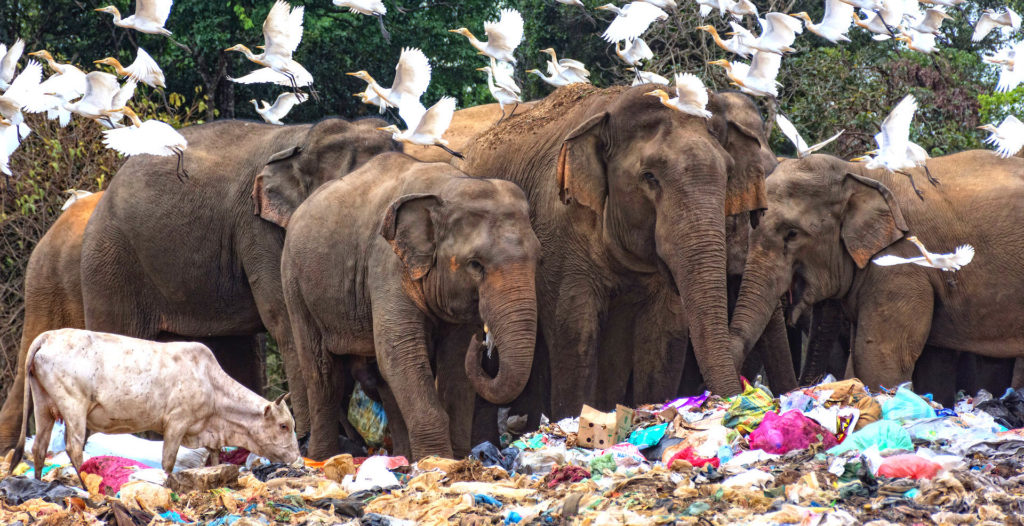Photo courtesy of Dumidu Padeniya
Today is World Elephant Day
There are less than 500,000 wild elephants in the world. These comprise of just three families, the African Bush (Savannah) Elephant, the African Forest Elephant and the Asian Elephant; all are classified as being endangered. Most of these live on the African continent. Of the Asian Elephant, current estimates place them at being less than 50,000 in number, 30,000 of whom live in India.
The extinction of elephants, if allowed to happen, will not represent just the elimination of one faunal species from the face of the planet. Considered a keystone species, that is an organism that helps define an entire ecosystem, without the elephant the whole ecological network they live in may collapse and endanger the existence of all of the other fauna and flora that share it with them. This loss of wild places and wild animals will inevitably impact humans as the environment and climate begin to change for the worse. This is in addition to the loss of direct economic benefits, such as from the tourism industry, with this disastrous demise of natural resources and loss of biodiversity services.
The current situation
Sri Lanka suffers the highest annual elephant and human deaths. According to the first national elephant survey conducted in Sri Lanka in 2011, the wild elephant population was estimated to be 5,879. However between 2012 and 2022, a minimum of 3,291 elephants have died. Seventy percent of these deaths had anthropogenic causes to them i.e., due to the activities of people. In 2022 alone, 439 elephants lost their lives. This year, too, at least one elephant has died on every day of the year.
Annual deaths in Sri Lanka due to the Human-Elephant Conflict from 2012-2022
The Human-Elephant Conflict has shown a steady increase in recent years and has now spread to more than half of Sri Lanka, with almost the entire dry zone being affected. Current approaches to managing wild elephants were first developed in 1959 and recommend confining all elephants to selected protected areas. This approach is outdated and was made on anecdotal rather than scientific evidence. If further proof were needed, for the past 60 years the Department of Wildlife Conservation (DWC) has been striving to achieve this goal and has failed.
The fundamental fact is that elephants are found on 62% of the land area of Sri Lanka, of which only 18% is officially protected. The balance 44% they share with humans and have done so for centuries. It is not possible to confine all of the elephants in to 18%. They will die horrible deaths due to starvation, disease, interbreeding and escalation in conflict as, being intelligent beings, they will try and break out and be killed. That is certainly the path to rapid extinction.
Other factors
Unchecked large scale deforestation and fragmentation and unplanned development activities taking place across the country have added to the escalation of the Human-Elephant Conflict. For example, due to unplanned development, the unseasonal filling of the reservoir, the annual gathering of wild elephants at Minneriya, considered as one of the 10 wildlife wonders of the world, is now endangered. Where 300 to 400 elephants were once to be seen of an evening, the largest such congregation of the Asian elephant, this number has dwindled to less than 100 on most days.
The continued illegal capture and internal trade of the body parts of elephants has had an impact on their conservation, with hardly any successful prosecutions resulting from such cases.
An arrested National Action Plan
A National Action Plan for the Mitigation of Human-Elephant Conflict (NAP) was prepared by a Presidential Committee comprising all stakeholders and was presented to President Gotabaya Rajapaksa in December 2020. The short, medium, and long term steps for such a multi-stakeholder approach are outlined in the plan. Sadly, and familiarly, it has yet to be implemented. Meanwhile, humans and elephants are dying.
Although the present government has set up a committee to facilitate the NAP’s implementation, it has not vested in it any proper powers or provisions to make it happen. While we join the world in celebrating Elephant Day, will we have any elephants of our own to celebrate in a few years’ time?
